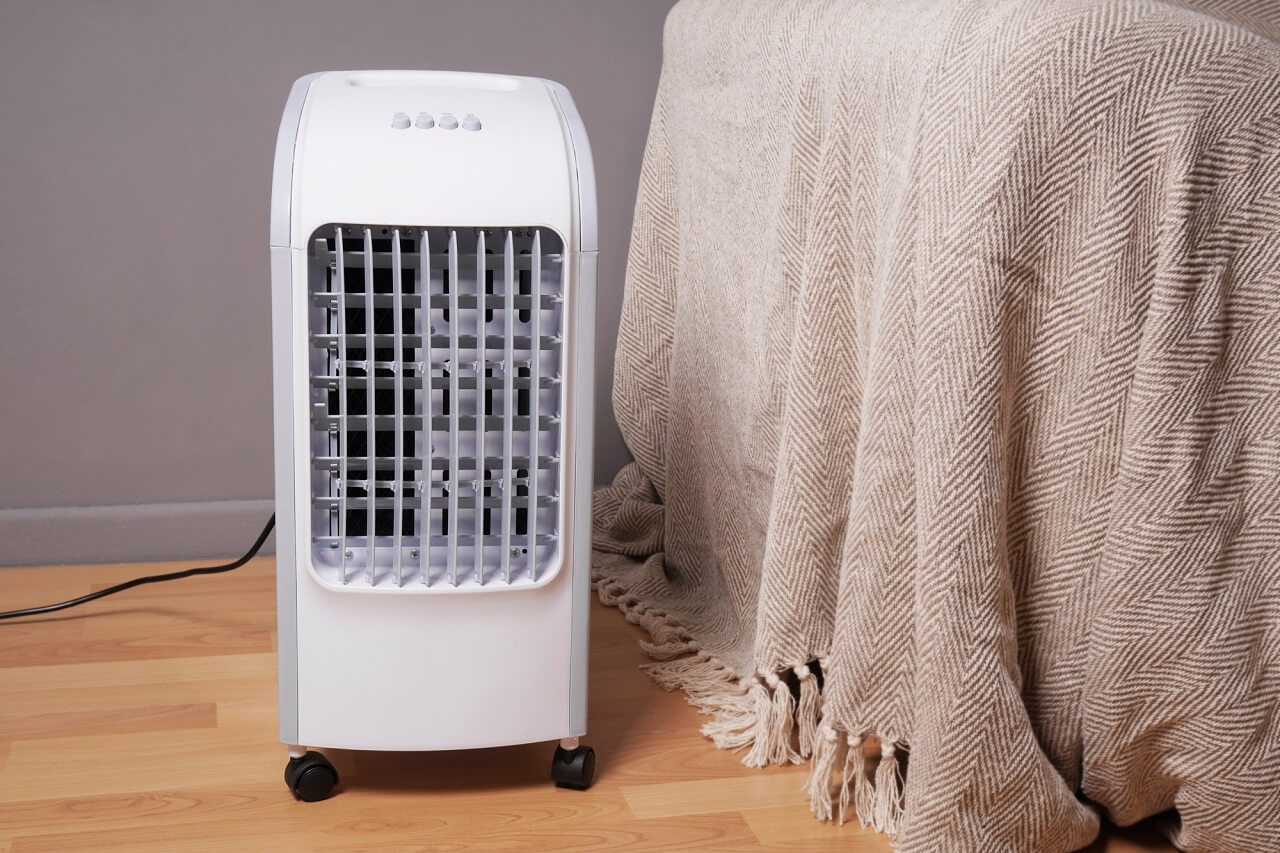When using an air cooler, you want as much ventilation as possible. This means opening all the doors and windows. This prevents humidity from building up in the room, which can be really uncomfortable and even bad for your health.
But if you have to use an air cooler in a closed room (maybe because there are no windows or it’s dusty or smoky outside), there are several ways to cool the room without raising humidity.
How Does An Air Cooler Work?

To understand why air coolers are not designed to work in closed rooms, you need to know they work.
When you stand at the shore of the ocean or a lake, you can usually feel a cool breeze blowing off the water. An air cooler, also called a swamp or evaporative cooler, works the same way.
A fan pulls air into the fan and forces it to pass through water-soaked pads (air coolers use a water pump to keep the pads saturated). The water evaporates, causing the air to cool down.
The fan blows the now cool air into the room. Here’s a short video demonstrating this process.
But the air is not just cooler, it is also humid since it’s carrying water vapor from the air cooler. So in addition to cooling the room, it also humidifies it.
That’s why air coolers are recommended for dry (low humidity) areas. For one, water evaporates more easily when the environment is dry. This allows the air cooler to cool a room faster and more efficiently.
Secondly, dry environments need the humidifying effect of an air cooler. The added moisture in the air makes the room more comfortable.
If you were to use an air cooler in a high-humidity environment, you won’t get any significant cooling since the water in the air cooler will struggle to evaporate (because ambient air is already carrying lots of moisture).
This drastically reduces the cooling performance of an air cooler.
Secondly, adding more moisture to an already humid environment can actually make it feel hotter. This is called heat index or apparent temperature.
Basically, when the air is humid, your body feels like it’s hotter than the actual temperature. Your body struggles to sweat and cool itself down. If high humidity persists or continues to rise, there’s a risk of heat stroke or heat exhaustion.
How To Use An Air Cooler In A Closed Room
It’s important to have outside air coming in when you are using an air cooler. You can open a window or door.
This allows fresh air from outside to get into the room and warm indoor air to escape outside. It also allows excess humidity to escape outside, ensuring the room stays cool and comfortable.
But what if opening the windows or door is not an option? Can you still use an air cooler?
Yes, you can, but with a few changes. Here are some tips to safely use an air cooler in a closed room.
1. Turn Off The Water Pump
At its heart, an air cooler is essentially a fan. The addition of a water pump and pads is what turns it into a cooler.
Most air coolers come with a setting that turns off the water pump, leaving just the fan working. In this fan-only mode, the air cooler is safe to use in a closed room.
That’s because it’s not putting out any humid air; it’s just moving indoor air around like any other fan.
Different air coolers have a variety of ways to activate this feature. Some have a button specifically for turning off the water pump.
Others have a button for activating fan-only mode and others have a setting that turns cooling mode on and off (turning off cooling mode deactivates the pump).
Check your air cooler’s user manual for instructions on how to use it as a fan.
Keep in mind that turning off the water pump greatly limits the cooling performance of the air cooler. As with a fan, it might help you feel cooler but only to a point.
2. Install an Exhaust Fan
Switching an air cooler to a fan-only mode will prevent humidity buildup, but it doesn’t offer much cooling. If you want to really cool a closed room with an air cooler, you have to find a way to exhaust the hot and humid air.
The best way to do this is using an exhaust fan.
Exhaust fans are great for cooling homes without using an air conditioner. The exhaust fan pulls heated air from the room and exhausts it outside, which makes the room cooler.
An exhaust fan can also reduce humidity in the room by expelling humid air outside. You can use it to keep the humidity at a comfortable level when using an air cooler.
Make sure the exhaust fan is installed high up on the wall where it can easily pull hot air and take it outside (hot air rises).
There are also exhaust fans designed for installation on a door or on the ceiling.
3. Use A Room to Room Transfer Fan
If the closed room is adjacent to another room that has windows, you can use the open room to keep humidity under control.
All you need is a room to room ventilator or transfer fan. These are typically installed on the wall dividing two rooms.
The fan pulls air from one room to the other room. Room transfer fans are typically used to distribute cooled or heated air around the house.
But you can also use it to keep an air cooler from adding too much humidity to a closed room. Install the transfer fan high up on the wall between the two rooms. Make sure you set it up in such a way that it pulls air from the closed room and into the open room.
Remember to keep the windows in the open room open to allow the hot and moist air to escape.
Keep the door to the closed room open to allow fresh air to flow in from other parts of the house. If you prefer keeping the door closed, consider installing a ventilator low on the wall between the two rooms.
It will allow cooler and drier air from the adjacent open room to flow into the closed room.
4. Place the Air Cooler Close To The Door
If it’s possible to keep the door to the closed room open, you can use it as the main source of ventilation in and out of the room.
Place the air cooler in the doorway with its backside facing outside the door. The cooler will draw air from other parts of your home and blow cool air into the room.
Hot moist air then escapes through the same door, but at a higher level. You can use a fan to help push the hot and moist air outside the room. Place the fan high up and direct it towards the door.
If you install the fan right on the doorway, even better. Just make sure it’s high up so that it drives the hot air out of the room.
To improve air exchange, open the windows in other parts of the house. Otherwise, you’ll be recirculating the same air and the entire house will become too humid.
Can You Use An Air Cooler Together With A Dehumidifier?
You are probably wondering why I haven’t suggested using a dehumidifier. It seems like it could allow you to use an air cooler in a closed room.
The dehumidifier pulls moisture from the air produced by the air cooler, keeping the room comfortable. And unlike air coolers, a dehumidifier can work in a closed room. It doesn’t need any venting.
But using an air cooler and dehumidifier at the same time doesn’t work as well as you’d imagine.
That’s because a dehumidifier puts out some heat when it condenses water vapor into liquid water. At the same time, you are trying to cool the room with the air cooler.
The two appliances cancel out each other, resulting in poor cooling. Running a dehumidifier and air cooler at the same time also uses a lot of electricity.
So while it looks like an obvious solution, running a dehumidifier and air cooler simultaneously doesn’t work. It will not cool the room sufficiently.
The Best Way To Cool A Closed Room
Instead of struggling to use an air cooler in a closed room, you could find another cooling solution altogether.
You can use central AC. But if you don’t want to cool the entire house or don’t have central AC, mini-split air conditioners work great.
You can install a mini-split on the wall to cool just that one room.
Another option is a window AC unit. It’s great if you have a window in the room but prefer keeping it closed.
Alternatively, use a portable air conditioner. A portable AC needs to be vented outside a window. But it comes with a kit that keeps the window closed, while allowing the AC to vent outside.
If the room has no window, you can still use a portable AC together with a door or wall venting kit.
The three types of air conditioners — mini-split, window AC and portable AC – offer excellent cooling performance in closed rooms as long as they are able to vent outside.
Unlike air coolers, these air conditioners can work in any climate whether humid or not.




